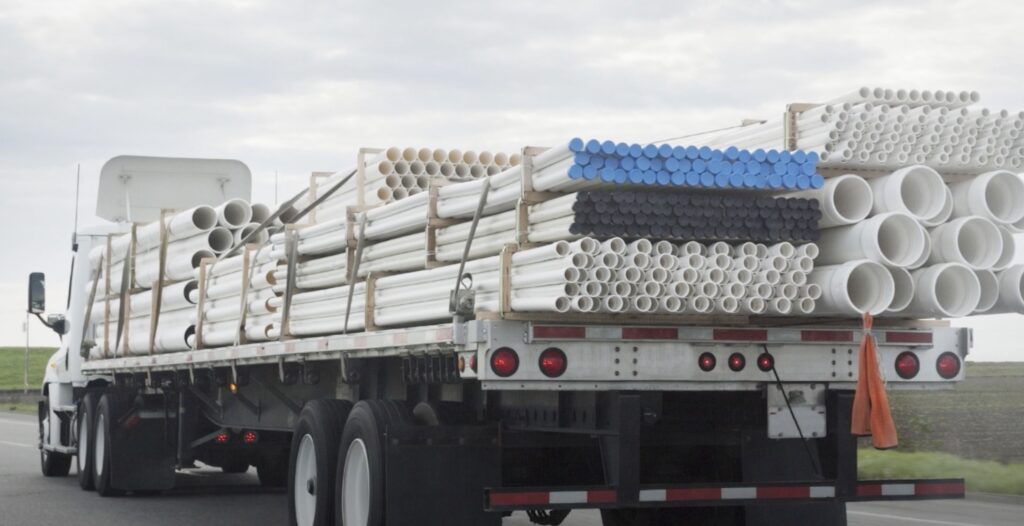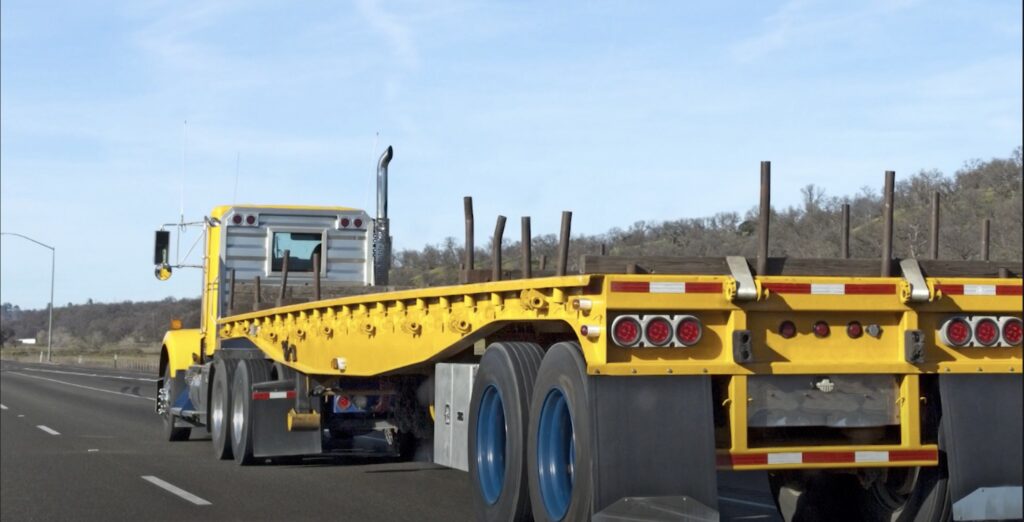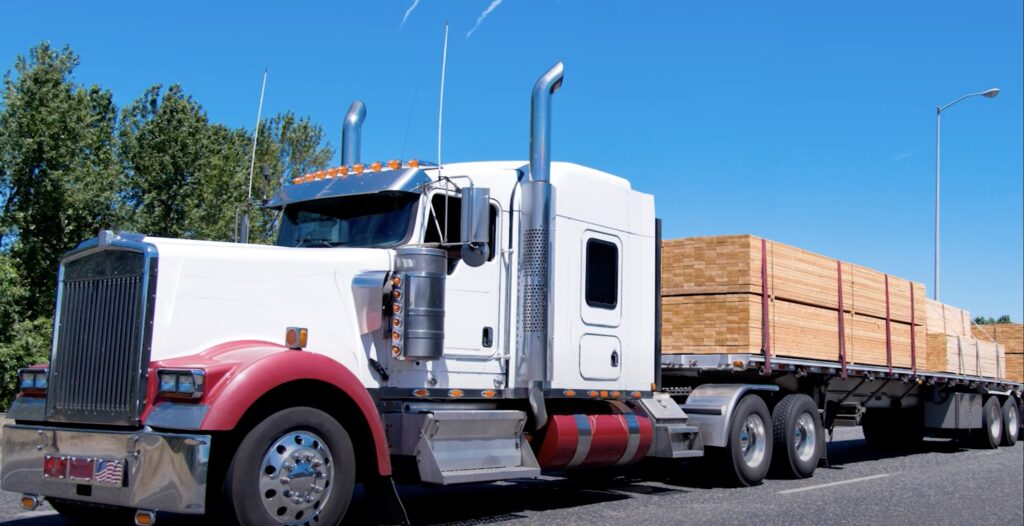
09/13/2022 by Christine Morris
A Sneak-Peek Into Flatbed Shipping
Flatbed shipping is an essential part of the logistics industry.
Flatbed trailers are incredibly versatile and offer many benefits to shippers. Not to mention, flatbed shipping has been on the rise in recent years. In this blog, we’ll divulge to you our comprehensive knowledge of flatbed shipping so you can master this transportation mode.
WHAT IS A FLATBED TRAILER? FLATBED SHIPPING?
Flatbed Shipping

Flatbed shipping is often the transportation choice for cargo that doesn’t need the enclosure of a dry van. It’s ideal for cargo that cannot be loaded or unloaded from a dock as the shipper or receiver can load or unload from a variety of ways. The design of a flatbed trailer allows for cranes and forklifts to unload and load goods from a loading dock, from the side with a forklift or crane, or from above with an overhead, gantry, or crawler crane. This makes a flatbed trailer versatile and critical for numerous loading and unloading scenarios including at job sites, warehouses, and distribution centers.
Flatbed Trailer

A flatbed trailer is the most common type of open-deck trailer used in commercial, over-the-road, long-haul, and specialized trucking such as oversized or over-dimensional shipments. A flatbed trailer is a 48ft or 53ft trailer, that can accommodate loads up to 48,000lbs. They typically have two axles, air-ride suspension, and kingpin for a standard 5th wheel hook up.

Flatbed Freight

Flatbed freight tends to be more industrial than truckload dry van freight. There is a wide variety of flatbed freight in the marketplace. Some higher volume products like lumber or building supplies will generally pay less than more industrial items that support our country’s energy and core infrastructure needs, like construction equipment, generators, fabricated steel, and other project or job site-related freight.
WHAT CAN BE HAULED ON A FLATBED TRAILER?
The most common freight shipping uses for flatbed trailers are:
o Formed concrete items
o Lumber
o Construction materials
o Steel beams
o Scaffolding
o Trusses
o Electrical transformers
o Oil, gas, and petrochemical equipment
o Solar panels or wind turbines
o Commercial heating and air conditioning units
o Landscaping materials
o Large quantities of wrapped and stackable products
WHAT INDUSTRIES USE FLATBED TRAILERS?
Because flatbed trailers have no enclosure, the freight they carry can be versatile and their use extends across several industries, such as;
o Housing
o Construction
o Renewable energy
o Agricultural
o Warehousing
o Manufacturing
o Mining and drilling
o Military
o Automotive
o Landscaping
WHAT ARE THE BENEFITS OF A FLATBED TRAILER?
There are several benefits to using a flatbed trailer for your freight. With a flatbed trailer, there is dimensional flexibility for loading or unloading freight since there are no physical walls or a ceiling to restrict its use. Any cargo that is oddly sized or irregular-shaped can be easily moved with a flatbed trailer.
WHAT ARE THE DISADVANTAGES OF USING A FLATBED TRAILER?
When selecting the type of trailer your freight needs, you should know the disadvantages of each. Compared to traditional hauls, all flatbeds take considerable skill, effort, and time.
Since there are no physical walls to restrain freight, cargo securement and balance are two significant concerns with flatbeds. The FMCSA has a lengthy section in rules specifically for securement, as insecure cargo is a serious safety hazard.
Proper securement is needed for your freight too because if not done correctly, your freight can get damaged from the securement itself. Also, shipments often shift some during transportation, so even weight distribution and securement are necessary.
Another disadvantage to flatbed trailers is that there are no physical walls. It’s a positive for loading and unloading. Still, it can also be a negative as no enclosure means dealing with the elements (wind, rain, snow, sun, animal or human interference, truck smoke/smog, dust, and road debris). To combat this, there is the option of tarping your freight or using a Conestoga trailer.
There are even more significant risks and responsibilities with any oversized freight as these shipments have even more strict regulations to follow.
Looking for all you need to know about Over-Dimensional Shipping?
FLATBED SHIPPING TIPS
Know your cargo
Be sure to know all the details of your shipment. This includes commodities, value, dimensions, and weight. This information will help logistics providers know how to properly secure your cargo ahead of time.
Understand what trailer you’ll need
Familiarize yourself with the different types of flatbed trailers before booking a shipment so you can make the most cost-effective and safe choice. Each type of flatbed trailer has certain limitations. For example, a specific flatbed trailer like extended trailers and Conestogas can be harder to find so your provider may need advanced notice when they are required.
Be aware of accessorial charges
Flatbed shipping may involve moving specialized loads which can need special equipment or extra services. Make sure you have the proper equipment and services needed for your freight to avoid extra charges, freight damage, or delays.
Choose to work with an expert
Arranging flatbed shipments on your own can be time-consuming and expensive, making sure all regulations are met and your cargo travels safely. Consider working with an expert in flatbed shipping to help secure capacity and locate the right equipment for your freight.
FLATBED RATES AND SEASONALITY
Freight shipping demand, which includes flatbed demand, is something that is often based seasonally. No matter the market, shipping rates fluctuate throughout the year and rise as the demand for freight rises.
Flatbed shipping is very closely connected to construction and industrial production, which can be highly dependent on the weather. These industries often slow down in the winter months, so normally, the demand for flatbed shipping will soften at the end of the year.
Smaller to medium-sized companies often slow down during winter and resume activity when warmer weather returns. However, larger companies are affected less by the seasonality and continue to move their commodities regardless of the time of the year.
Because of the seasonal rise and fall, you’ll find volume and rates lowest in the late fall/early winter, with the peak flatbed season being from April to October. This is when the volume of flatbed loads is highest, as are the rates.
FLATBED SHIPPING WITH TRINITY LOGISTICS
Did you know Trinity Logistics is an industry leader in brokering flatbed freight to small and midsize carriers throughout North America?
Our vast network of Independent Freight Agents, combined with our Regional Service Centers deliver the best-in-class flatbed shipping through our expert carrier relationships. We accomplish this by supporting core energy and infrastructure clients with their project-based, unique, and often specialized freight.
Learn more about Trinity's services

